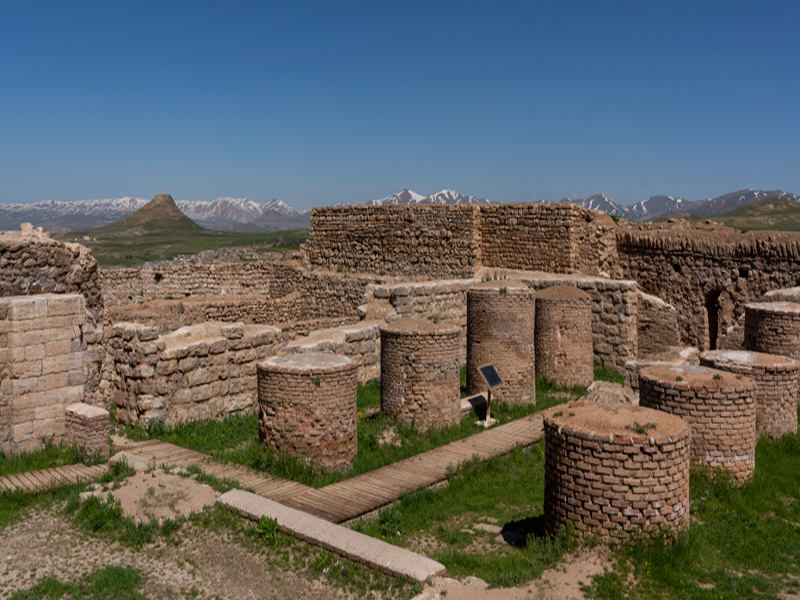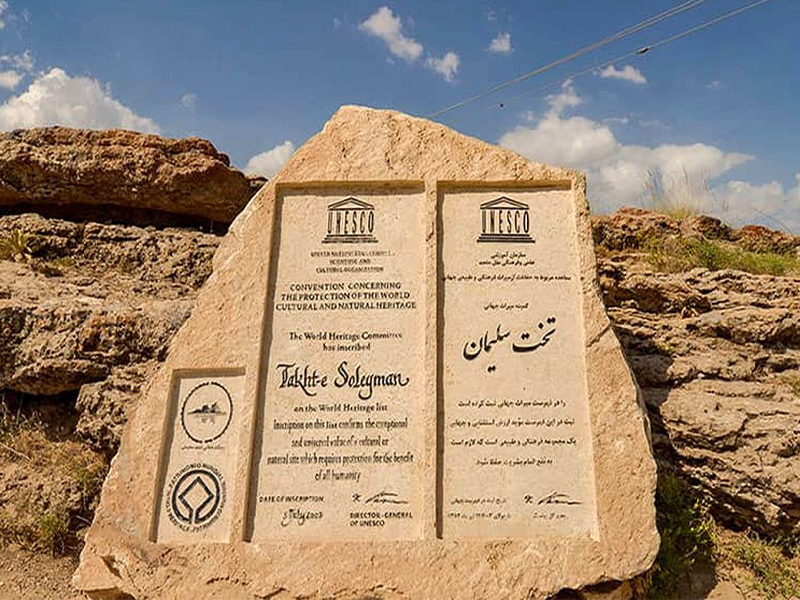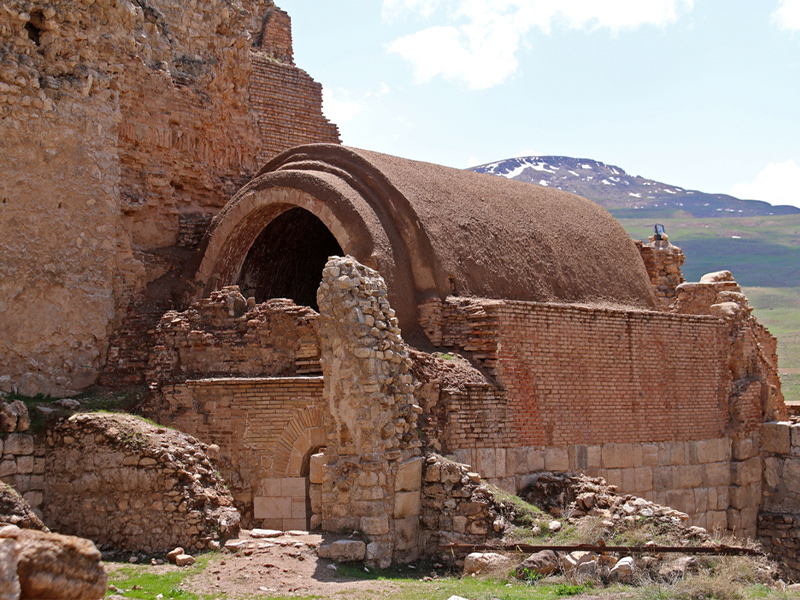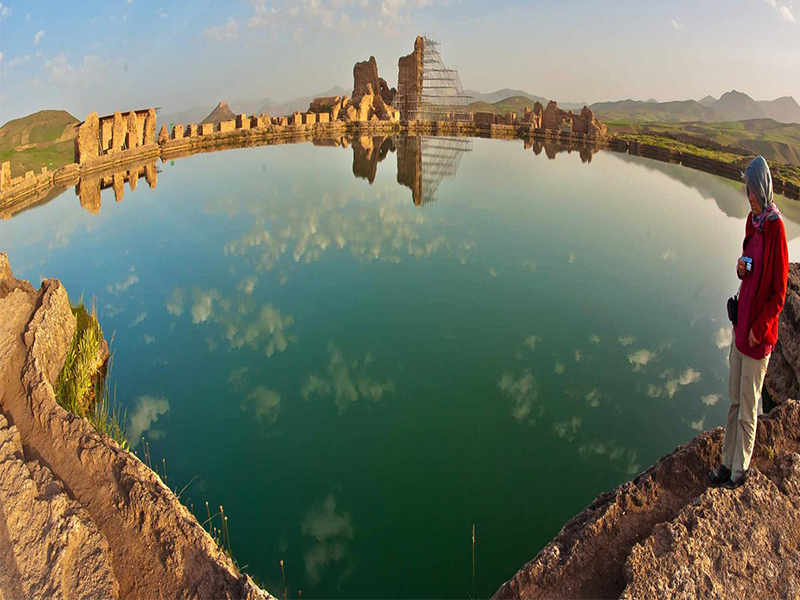All of us, whether rich or poor, have a strong desire to either accumulate wealth or experience the thrill of discovering a treasure or even finding a bag of money falling from the sky. Have you ever been in such a place or moment? A moment when you find yourself somewhere and acquire a windfall? It must have been an interesting experience. Today, we want to explore and examine a place that is said to make you feel wealthy as soon as you enter it, or better yet, make you wealthy. Join us at Eligasht as we get to know and examine Lake Takht-e Soleyman, a place that makes everyone rich.
Book Iran Air flights from London to Tehran and Tehran to London with Eligasht UK:
introduction
At the beginning of this article, we must mention that apart from geographical specifications and proven and documented materials, all the information we have gathered is based on rumors and whispers. We neither confirm nor deny the accuracy of this information. Let’s get acquainted with Lake Takht-e Soleyman. Located 45 kilometers northeast of the city of Takab, there is an ancient site that is said to have hosted sacred structures within its walls for the past 1600 years. Alongside Lake Takht-e Soleyman, it has many famous historical and ancient artifacts, which are among the most important and well-known centers of Iranian and global history and civilization. Its value is such that it has been included in the UNESCO World Heritage List, which is evidence of its claim that this region is not only wealthy but also has the ability to make people rich.
Every year, thousands of domestic and foreign tourists visit the vicinity of Takab and the village of Takht-e Soleyman in West Azerbaijan Province to see this beautiful and extraordinary lake. Lake Takht-e Soleyman, with an area of approximately 124,000 square meters, is located in West Azerbaijan Province and has preserved the history of the presence of Medes, Ashkanians, Sassanians, and Mongols in various historical periods in this region.
Related post
Travel Guide to Kurdistan
Best Natural Attractions in Iran from the Perspective of Tourists

How can one reach this area?
This extraordinary historical attraction is located approximately 32 kilometers northeast of Takab in West Azerbaijan Province. The journey from Takab to this area takes about 44 minutes. First, you need to travel from Takab to Agholbeyk, then continue your route towards Qareh Bala. After passing the village of Baba Nazar, head northwest and travel 4.4 kilometers to reach this area.
We recommend including a visit to Urmia City (the capital of West Azerbaijan Province) in your travel itinerary to this ancient region. Urmia offers beautiful tourist attractions, including historical and natural sites, that are truly captivating.
The best time to travel to Takht-e Soleyman
The Takht-e Soleyman complex has its own beauty and special charm in every season of the year. However, the best time to visit this area can be considered the spring season and early summer, from the month of Ordibehesht (April/May) to Tir (June/July), when the weather is still mild and the mountains and surrounding nature are all lush and adorned with colorful flowers.
Certain parts of the Takht-e Soleyman complex are illuminated at night, making nighttime walks and capturing the beauty through photography a delightful experience.
The history of Takht-e Soleyman
As we mentioned, the historical artifacts found in this place belong to the Parthian, Sassanian, and Ilkhanid periods, with the most important ones being the fire temples and halls of the Sassanian period.
Apart from these, there are Sassanian artifacts, and the rest are built in Mount Belqeis and Soleyman’s Prison. Now, why do we say that you will become rich by visiting this area? Before the Islamic era, the Takht-e-Soleyman Lake complex was the largest religious, educational, and social center, but in 624 AD, the Roman Emperor attacked this region and destroyed this complex.
What has made this complex still attractive and unique is the use of carved stones and large bricks in the construction of this historical structure and the existence of the strange and ever-boiling lake called Takht-e-Soleyman, which has a depth of 112 meters in the middle of this complex. The water of this lake is supplied from underground reservoirs because it maintains a constant temperature of 21 degrees Celsius in winter and summer. Some believe that this lake is the place where Solomon buried his treasure, and that’s why it is known by this name. Of course, other stories are also not out of the question! In the 7th century AH, Agha Khan, the Ilkhanid ruler, used to come to Takht-e-Soleyman for his summer vacations, and during this time, he built structures such as the Council Hall, the Eastern Pavilion, and the 8 and 12-sided buildings, which revitalized this historical site.

Bahram V, the Sassanian King, built this area like a city, and 70 years after him, Qobad I expanded its structures until it reached its peak during the reign of Khosrow Anushiravan, the Sassanian King. The reason we say with certainty that the antiquity of this area is more than what has been discovered so far is that signs of human presence and remains from the 1st millennium BC to the 11th century AH have been found in this 12-hectare expanse, revealing the secrets of the city to experts.
Architecture and Layout
From where is it known that this antiquity is not limited to these periods alone? Takht-e-Soleyman, the historical castle that, according to the latest information obtained from the Sassanian period, has various sections such as the Azargoshnasp Fire Temple, the Shahi Fire Temple, and the Warriors’ Fire, Khosrow’s Palace, gates, and fortified walls. It is one of the most important historical sites in the world. All the structures in this complex are built inside an oval-shaped rampart, which is surrounded by a vast plain.
Inside this oval rampart, there are two concentric but different central squares, with a lake in the center of the southern square and a fire temple in the center of the northern square, surrounded by a rectangular rampart along with circular towers. In the northwest of Lake Takht-e-Soleyman, there is a lofty terrace made of red bricks and Sarooj mortar, known as the Khosrow Terrace. The terrace leads to two rooms or the seven-sided house, belonging to the Ilkhanid period. Outside Takht-e-Soleyman, in the southwest, there is a 300-meter-long and 4-meter-high stone moat, which the locals also call the Stone Dragon. To see the historical structures in Takht-e-Soleyman, you should go around the sedimentary spring near this lake. The water of this lake emerges from a depth of more than 120 meters underground and contains so many salts that it is not used for drinking and agriculture.
The Azar Goshnasp Fire Temple
One of the most iconic structures at Takht-e Soleyman is the Azar Goshnasp fire temple. This temple, dedicated to the Zoroastrian deity, housed the sacred eternal flame. The temple was designed in a circular shape, with a central courtyard and an elevated platform supporting the fire altar. The layout of the temple was carefully planned to symbolize the cosmic order in Zoroastrian cosmology.

The Zendan-e Soleyman (Prison of Solomon)
Another remarkable feature of Takht-e Soleyman is the Zendan-e Soleyman, also known as the Prison of Solomon. This structure is a deep circular hole in the ground, surrounded by concentric walls. Legend has it that King Solomon imprisoned supernatural creatures, known as divs, in this mysterious pit. The Zendan-e Soleyman is a testament to the mythical and mystical elements associated with the site.
The Lake and Surrounding Structures
Takht-e Soleyman is also home to a large artificial lake, known as the Zendan-e Soleyman Lake. The lake, fed by natural springs, added to the grandeur of the complex and provided a serene and picturesque setting. Surrounding the lake are the ruins of various buildings, including a palace, a treasury, and residential areas, showcasing the architectural prowess of the Sassanian Empire.
UNESCO World Heritage Site
In recognition of its rich history and architectural significance, Takht-e Soleyman was inscribed as a UNESCO World Heritage Site in 2003. The organization acknowledged the site’s outstanding universal value and its contribution to world heritage. The inscription has helped in the preservation and conservation efforts of the site, ensuring that future generations can appreciate its historical and cultural importance.

Final words
In the final analysis, Takht-e Soleyman is more than just a historical site. It is a place that inspires wonder, sparks curiosity, and fosters a sense of connection to something greater than ourselves. It is a treasure trove of knowledge and a testament to the enduring legacy of our ancestors. May we continue to cherish and preserve cultural treasures like Takht-e Soleyman, ensuring that future generations can also marvel at the wonders of the past and draw inspiration from the footsteps of those who came before us.
FAQ
What is Takht-e Soleyman?
Takht-e Soleyman, also known as the Throne of Solomon, is an ancient archaeological site located in northwestern Iran. It is a UNESCO World Heritage Site and is considered one of the most important historical and religious complexes in Iran.
What is the significance of Takht-e Soleyman?
Takht-e Soleyman holds great significance both historically and culturally. It was an important religious center during the Sassanian Empire (224-651 CE) and served as a Zoroastrian fire temple. The site is associated with legends and mythologies, with references to the legendary king Solomon. It also contains the remains of a fortified structure, a temple complex, and a lake.
What can visitors expect to see at Takht-e Soleyman?
Visitors to Takht-e Soleyman can explore various architectural elements and ruins. The most prominent feature is the large circular platform, which is believed to have held a grand palace. The ruins of the Anahita Temple, dedicated to the goddess Anahita, can also be seen. Additionally, the site includes a sacred lake called Zendan-e Soleyman, or the “Prison of Solomon,” which adds to the mystical ambiance of the place.

